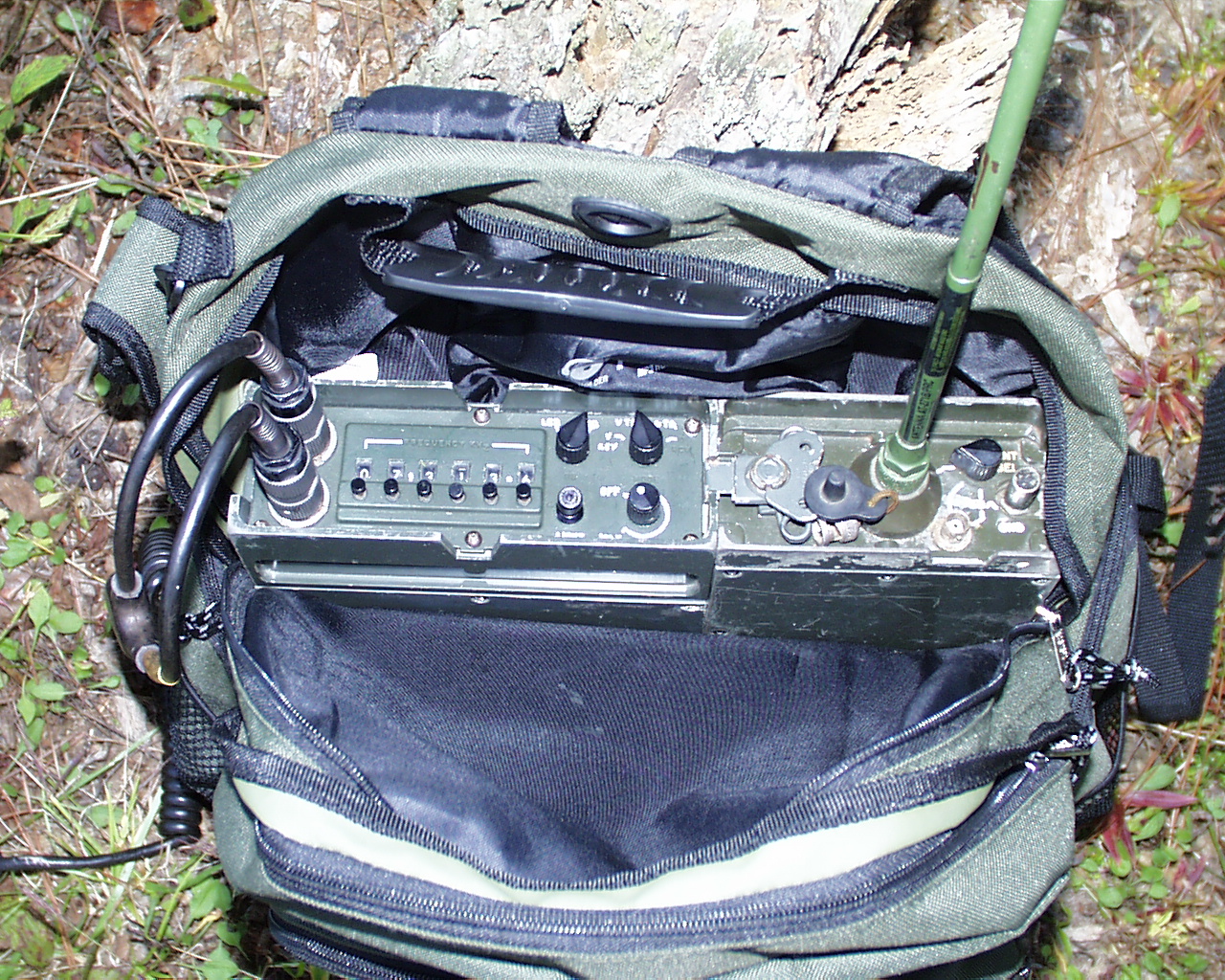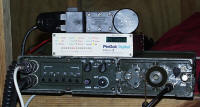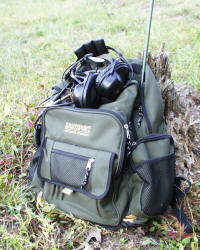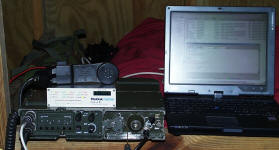 |
PRC-104 Military HF ManpackThe PRC-104 is a fun radio to do portable & pedestrian mobile with. While not as light as the VX-1210, it's very usable. RF characteristics are great, and and integrated autotuner works well with whips or long wires. You won't find a more rugged radio. This Hughes design was made to last! |
 PRC-104 HF Manpack
PRC-104 HF Manpack
One of my favorite radios was an ex-military PRC-104 (Sadly, now sold). It's a 25-30 watt HF Manpack with integral auto-tuner made by Hughes and Tadiran. These radios are fairly current and are just now being phased out for newer radios. Most were used with various special forces. Given where my unit was surplused and it's evidence of many amphibious ops, it's most likely it served with the SEALS.
There are many excellent sites with history and specification about the radios. I won't try to duplicate their information, as they have done a great job of documenting nearly all known facts about the PRC-104:
| Brooke Clarke N6CGE | http://www.pacificsites.com/~brooke/PRC104.shtml is a very comprehensive site on military radios and accessories, including the PRC-104 & family |
| David McGiness | http://www.co.missoula.mt.us/acs/radios/PRC-104.htm has lot's of good info on the PRC-104 and it's accessories. David has views of the different components & PC boards |
| DH4PY's GreenRadio | http://www.greenradio.de/e_prc104.htm |
| John K6ERO | John's Mutt Motor Pool site has lot's of info on his Mil-Pack radio experience |
| Columbia Electronics | http://www.columbiaelectronics.com/an_prc_104_hf_portable_radio_set.htm has factory information and still sells some components available |
Batteries:
Powering the PRC-104 is quite straightforward. There are two battery box options available:
| CY-7875 |
CY-7875 Battery box for the BB-X90 standard battery packsThis battery box was introduced with the PRC-104A. It allows the standard military BBx90 type batteries to be used. It's a bit larger than the original battery box, but has the capability to easily hold 10 AH of 28v NIMH batteries. Most have found the surplus SLA BB-390's to be unusable, but the cases can be salvaged and stuffed with NIMH cells. A very nice option is to use Brooks BB-590 battery adapter, which allows conventional NiMH cells to be used in equipment made for a BB-x90. More info at: http://www.pacificsites.com/%7Ebrooke/5590BA.shtml I lucked into a pair of fresh BB-3390/Bu NiMH packs. These test out at a full 5AH each, so with both packs I have a very good run time with the PRC-104. To date no one has found a schematic for the charger circuit. We suspect it's made for the SLA packs and would not be useful for NiMH. |
| CT-7451 Battery Box |
CY-7451 Battery BoxThe original battery for the PRC-104 used silver-??? cells in this battery box. While the silver cells are not available or practical, this pack will happily hold twenty 5AH NiMH C cells. It will also hold forty 4/3A cells, also available in 4-5AH. But this is a far more expensive option as the 4/3A cells are $5-6 each. In the past, some have found the 4/3A cells for $1.50 each surplus, and you can see an example here. I've used button C cells with a home made holder, but now are using a welded pack from battery space. Mine is a 10x2 configuration of 5AH Nimh C cells. You have to remove the heavy rubber shrink wrap, but once you do the pack will fit in the box with a very snug fit. If the pack has the two strings staggered into a trapezoid shape it will fit will a bit more clearance. My next pack will be to use Li-Ion cells with a controller board. The only downside is that most chargers will not charge 28v worth of Li-Ion cells in series. So I'll have to break it into two strings and charge it as two 14.4v packs. |
| Triton Charger |
Triton Charger by ElectriflyAfter quite a bit of research I selected the Triton charger as it is one of the few smart chargers which will charge 20 NiMH cells at once. It will also do SLA, NiCad, Li-Ion, and Li-Poly. It's become my primary charger. I bought mine here, and found this shop to be quite price competitive and had great customer service. I have not added a thermistor internal to the pack, but will as it allows the most accurate recharging. Even without the thermistor the Triton works well, and you can set the delta-V voltage to suit your needs. I run mine fairly conservatively. |
| Charge Adapter |
Charge Adapter for the PRC-104 connectorThe CY-7451 battery boxes do not have external charge connectors, though they can be added in the vent location. But I made up this adapter to allow easy recharging without modifying the battery box. Since the original cables connect to the boxes and radio are very hard to find, this approach works well. |
Backpacks:
The PRC-104 is a bit wider than many of the common manpacks. It was designed for the ALICE Pack, and was issued with one. While the Alice pack works and is cheap, I have found some other alternatives I prefer:
| British Radio Pack | It's hard to beat the British Radio Pack for overall flexibility and "mission suitability". Though most had dismissed it as too small for the PRC-104, I went ahead and tried it and found it worked quite well. It's a snug fit in width, but zips close with no stress/strain. I've found the snug fit actually helps a bit as it reduces movement with a whip antenna deployed.
To use the PRC-104 in this pack I had to extend one of the internal straps with a bit of webbing and a slide-lock buckle. Completely removeable, and holds the radio well. The "rocket launcher" pockets are great for holding the audio accessories and AT-271 whip. There is an internal pocket which will hold the AB-??? spring base. Even with the PRC-104 loaded there is room in the bottom of the pack, for rainjacket, lunch, water bottle, etc. It's also possible to buckle the radio in at the bottom of the pack. It's a little harder to change frequency this way, but does have the advantage you can stand the pack upright, which you cannot do if the bottom of the pack is empty. |
 |
This pack was mentioned on HFPack. I had to take a look, and it turned out to be a useful pack. Especially for $14! While I initially bought it for use with smaller radios, it turns out it is wide enough to carry the PRC-104 with no problems. It's not as sturdy as the British Radio pack's Cordura construction, but it's well padded and should be OK for light duty usage.
It's a bit of a trick to find these, they are typically found in the boys/girls section as "back to school" items, and not in luggage or sporting goods as the store employees would tell you. |
| Custom Packs | John K6ERO had a nice custom pack which came with one of his radios that I might try to duplicate. The PRC-104 is actually pretty compact, much smaller overall than either the British or Alice pack. |
| Alice Pack | This is the original pack. It certainly will carry the PRC-104, but from both an ergonomic and general usability aspect is not as nice as the other packs. The big issue is the "radio Pocket" is too large for the PRC-104, and it is not as secure when walking with a whip.
I do think an Alice frame could be modified to carry a 104 similar to the dedicated PRC-77 carriers with a bit of aluminum angle. I may make this mod just to be able to have the radio visible at hamfests rather than buried in a pack. (People like to see the radios) David McGinnis's site has some nice photo's of the PRC-104 in the ALICE Pack. |
Antennas:
| AT-271 | I use the plain jane AT-271 more than anything, often without the spring base. If not in motion, or in clear fields it works quite well without the spring. With the AB???? spring you really have to be careful in crowds, as it will spring forward and hit people if you bend over slightly! |
| AB-XXX Spring Base | |
| Shakespear Coil | For lower bands I add an old Shakespere coil to the mix to increase the inductance. Though the tuner will match 60m and higher with just the AT-271 whip, it works a bit better with a coil. |
| Buddi-Stick | Others use a Buddi-stick with good results. See K6ERO's "Bushwacker" page for more info. This is probably the optimal setup for pedestrian mobile on the lower bands. Bud W3FF has a great product, and is a nice guy to boot! |
| Vertical wire | I keep a small coil of wire and line in the pack. It's easy to toss up into a tree and raise a 25' vertical whip. I use the AB-xxx base to attach it to the radio feedpoint. |
| Counterpoise | |
| Fan Dipole | |
Data Modes:
 The PRC-104 is ideal for usage with modes like PSK and Pactor, as it is setup already for data. Just throw the switch, and you bypass compression and AGC for use with fsk.
The PRC-104 is ideal for usage with modes like PSK and Pactor, as it is setup already for data. Just throw the switch, and you bypass compression and AGC for use with fsk.
I made a data connector using an old U-229 connector and a keyboard extension cable. I have standardized on the Yaesu/Icom mini-din pinout, and it works well. As both the PRC-104 and the Yaesu 897/857 rigs all have 600 ohm audio it's trivial to interface, no transformers needed. So I have a common connector on all my audio devices, from modems to laptop cables, and even my VIC-1 intercom in the Pinzgauer.
In this photo I'm using the 104 for Pactor. I set this up at Boy Scout summer camp as an experiment. With a low fan dipole I had email connectivity via winlink2k / Airmail for most of a week without recharge. You are only drawing current when checking email, and even checking 3-4 times a day is less than an hour's operation.
With modes like Pactor and PSK you need to set up the audio drive using a watt-meter. Starting with the audio drive from the PC very low, slowly advance it until you have close to full power. Advance it until you do not see a corresponding increase in power level, then drop back until the power level just starts to decrease. This is about optimal.
Operating Experience:
The 104 is a very easy rig to operate, largely just set the frequency, and go. Audio tones let you know the state of the antenna tuner, etc. Likewise, "clicking" indicates state of charge (below 20v).
The AGC is very aggressive, and sometimes it can make you think the radio is "clicking" when you unkey and there is a strong signal present. But the receiver is quite "hot", and it's reasonably selective, though not a contest rig.
After using modern DSP rigs, you do realize how much the DSP reduces static levels. On a whim I hooked up a $10 Radio Shack DSP/Speaker using the data cable, and it worked great. For demo's it's quite handy. I'll be modifying the RS DSP to take 28v, and will rig up some type of cable to feed it from the radio's battery.
Transmit audio is quite punchy, and there is normally quite a bit of compression. You may have to try several handsets, and Mark KI0PF rates the H-250 as middle of the pack for TX audio. I have swapped between a few, and have 1-2 that get good reports. I also use my favorite H-161 headset for serious operating.
Maintenance:
The PRC-104's are quite rugged, and the only work I have had to do involved corrosion from military service near sea-water. The radio is completely gasketed, so inside mine was fine. But the audio connectors & knobs were very corroded, and the faceplate was starting to show corrosion where the paint had worn. When a decade switch became finicky, I looked for some help.
Jim KA8TUR fixed me up with a new circuit board, connectors, and knobs. I disassembled the faceplate, cleaned up the corrosion on the faceplate itself, and repainted with the correct 34052 paint. (Mine was in the Marine green colors). It made all the difference in the world, and the radio operates great with the newer decade switches and knobs.
I need to use either a lacquer stick or draftsman pen to redo the lettering. I tried a Pentel paint pen. It worked OK, but the lacquer stick is the best way to go it appears.
Hints: The clear plastic lens over the decade switches can be removed very gently. A little plastic polish will help. Make sure you use a glue which will seal the faceplate, but not fog the plastic. It's important it's sealed as that keeps moisture out of the decade switches.
The faceplate gaskets are often torn, oxidized, etc. It's not that hard to make another out of rubber or neoprene. The side covers have an O-ring, and these survive better. A little silicon grease will help them seal.